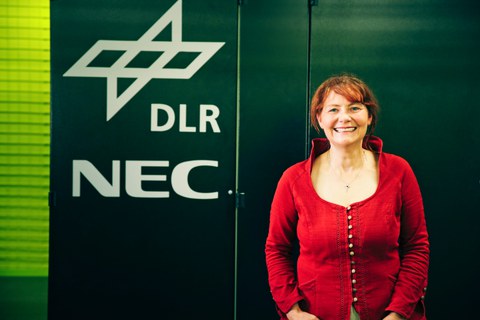Jul 25, 2024
New research infrastructure for climate-friendly aviation

Professorin Sabine Roller leitet das Institut für Softwaremethoden zur Produkt-Virtualisierung
At the Institute of Software Methods for Product Virtualization at the German Aerospace Center (DLR-SP), the software for more environmentally friendly aircraft is being programmed under the direction of Prof. Sabine Roller: Digital twins, simulations and other programs for future aircraft powered by electricity, hydrogen or synthetic kerosene. Since it was founded in 2017, the team has grown to 62 computer scientists, physicists, mathematicians and other experts. The new institute building next to the Andreas Pfitzmann Building, which cost around 12.8 million euros, was inaugurated for them on July 18 in the presence of DLR CEO Prof. Anke Kaysser-Pyzalla and Saxony's Economics Minister Martin Dulig. With a floor space of 1,568 square meters, the building provides offices, meeting rooms and IT laboratories for around 90 scientists and administrative staff.
From the fall, the SP experts will be working here on using digital twins to record the entire life cycle of machines from design to recycling. They also want to use digital simulations to streamline the certification process for new aircraft. In addition, predictive maintenance of jets is gradually becoming possible. This predictive maintenance technology is intended to make unnecessary upgrades superfluous, but also to identify emerging weak points more quickly.
"The inauguration of the DLR Institute for Software Methods for Product Virtualization (DLR-SP) is a strong signal that we in Saxony are actively shaping the future. It is an important player at the interface between computer science and aviation. In the direct vicinity of the Faculty of Computer Science at the Dresden University of Excellence, the Institute will contribute to the further growth of the flourishing software landscape in Saxony," said Martin Dulig, Saxony's Minister of Economic Affairs.
The institute's staff are also delighted with the new building. "Preparations for the move, which is expected to take place at the end of September, are currently in full swing. We are particularly looking forward to being able to design projects together with our partner institutes and industrial partners in the future and to carry out software sprints for the development and use of software, for which we have lacked the space and equipment to date," added Professor Sabine Roller.
DLR-SP has already installed a multi-million petaflop supercomputer,Cara, for the calculations in the neighboring Lehmann computer center in 2020. The Center for Information Services and High Performance Computing (ZIH) at TU Dresden is responsible for its maintenance and operation. Incidentally, the ZIH uses the waste heat from Cara & Co. to heat the new DLR building in winter, and in future will also partly heat the Dresden district heating network.
